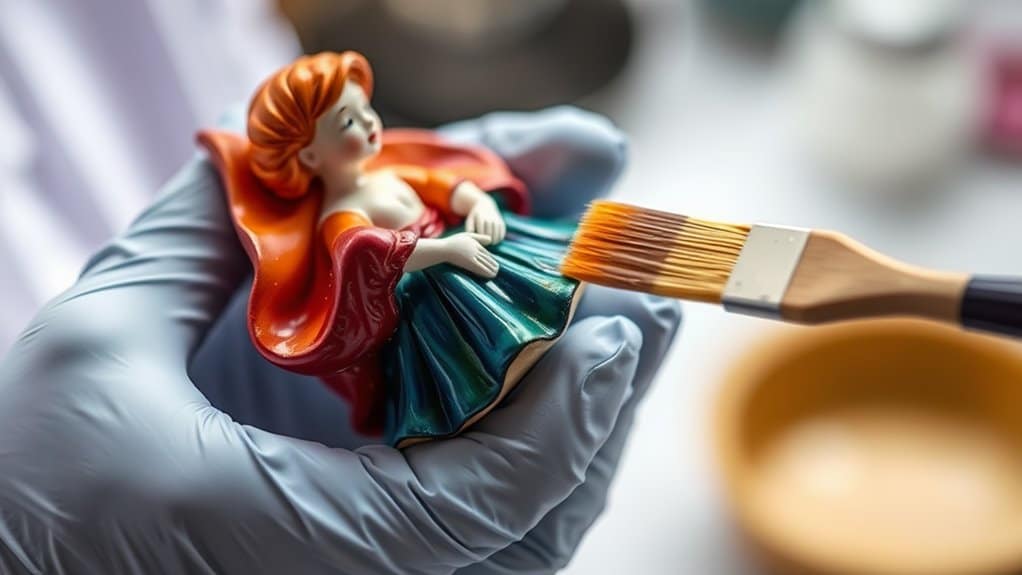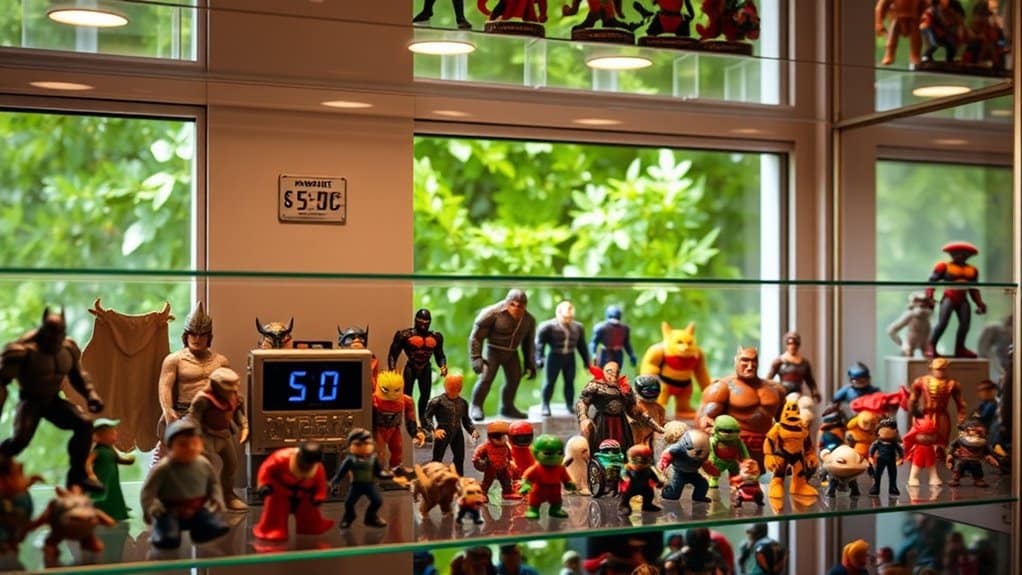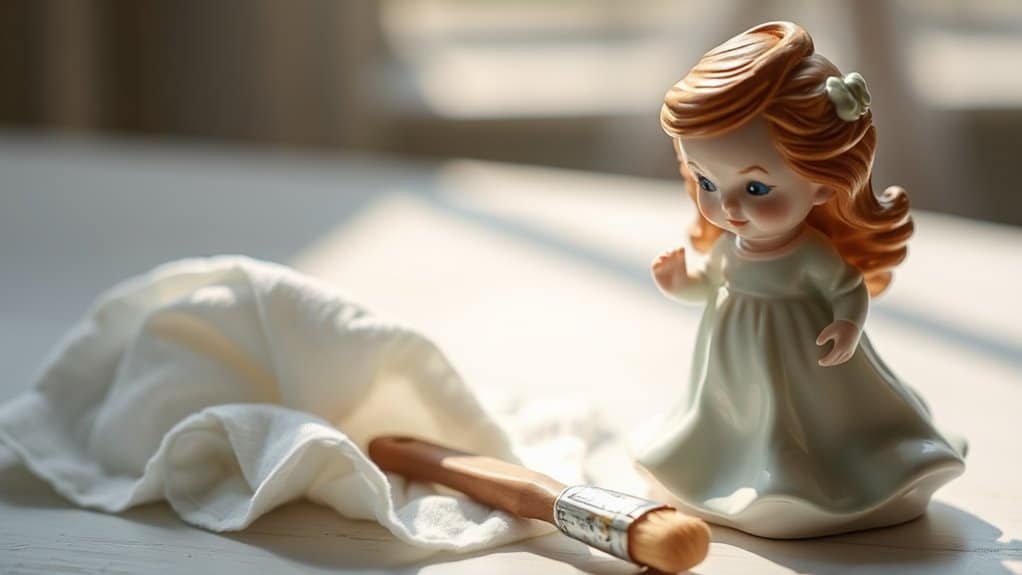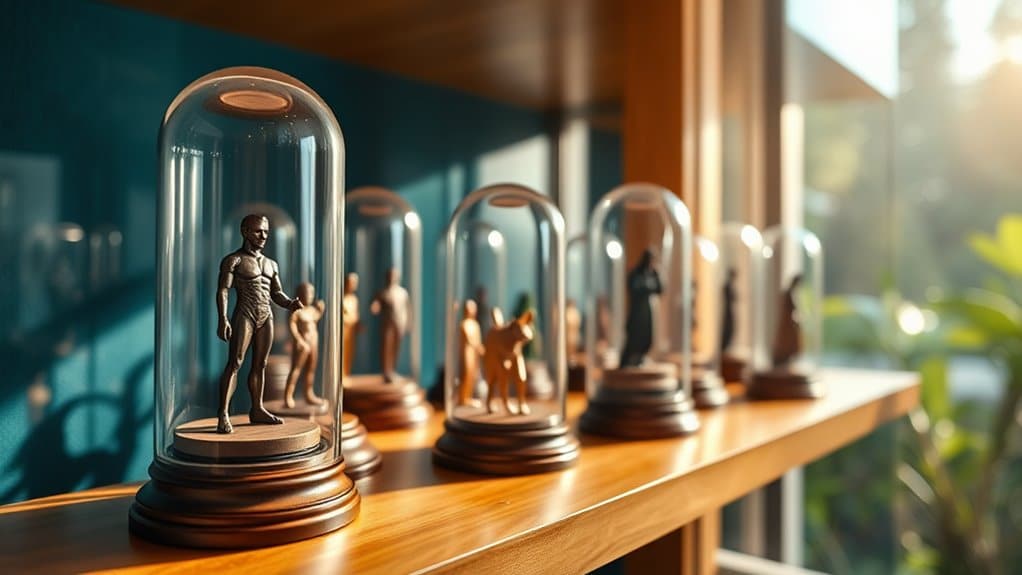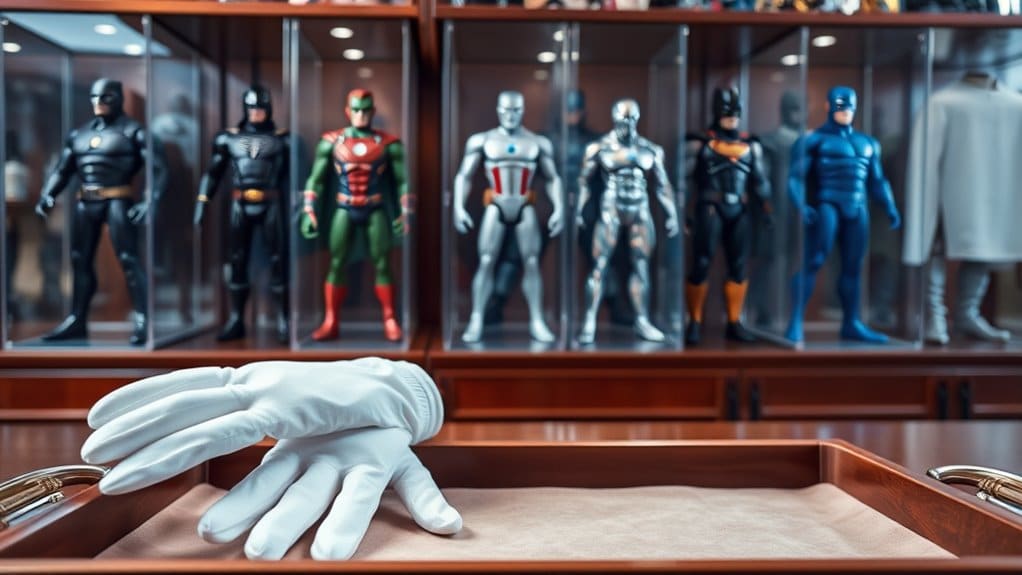To protect the paint on hand-painted figurines, keep them away from direct sunlight and maintain temperatures between 65-75°F with 40-50% humidity. Use soft brushes for gentle dusting and test-safe cleaning solutions. Always handle figurines with clean hands or gloves to avoid smudges. Apply a protective coating like clear acrylic spray, watching for paint deterioration signs. With these practices, your figurines will remain vibrant and cherished, and there are additional techniques to discover.
Choosing the Right Display Environment
When displaying hand-painted figurines, the environment you choose plays a crucial role in maintaining their vibrant colors and intricate details. You should focus on creating a stable setting that avoids extreme temperatures and humidity levels. Fluctuations can cause paint to crack or fade over time. Make sure the area is clean and dust-free, as dirt can accumulate on surfaces, dulling their appearance. Consider placing them in a display cabinet or a dedicated shelf. This not only showcases your figurines but also protects them from accidental bumps or knocks. Use soft lighting to illuminate the pieces without creating glare. Remember, a well-thought-out environment enhances the beauty of your collection while preserving its condition for years to come.
Minimizing Direct Sunlight Exposure
To protect your hand-painted figurines from fading, consider using UV-resistant display cases to block harmful rays. You can also strategically place them in areas away from direct sunlight. For an extra layer of protection, install window film solutions to filter out UV light.
UV-Resistant Display Cases
Although direct sunlight can brilliantly illuminate your hand-painted figurines, it poses a major threat to their vibrant colors. UV rays can cause fading and deterioration over time. To safeguard your collection, consider using UV-resistant display cases. These cases are designed to filter out harmful UV light, preserving the original hues and details of your figurines.
You'll find that investing in such cases is a proactive way to protect your treasures without sacrificing visibility. Look for options with high UV protection ratings and make sure they fit your display space. By encasing your figurines in UV-resistant cases, you're taking an essential step in maintaining their condition. This simple measure can greatly extend the life and luster of your cherished pieces.
Strategic Placement Indoors
Even if your hand-painted figurines are safely tucked away from direct sunlight, their placement indoors still matters greatly. You might think they're secure, but sneaky rays can bounce off surfaces and still reach them. To guarantee their longevity, consider these strategic placements:
- Avoid reflective surfaces: Mirrors and shiny tables can redirect sunlight onto your treasures.
- Choose indirect lighting: Position them where they benefit from ambient light, but not direct beams.
- Rotate regularly: By shifting their position occasionally, you can prevent uneven fading.
Each of these steps helps reduce the risk of paint deterioration. Remember, consistent vigilance is key. By considering their indoor location carefully, you'll keep your figurines looking vibrant and full of life for years to come.
Window Film Solutions
While strategic indoor placement is a great start in protecting your hand-painted figurines, window film solutions offer an added layer of defense against sunlight. By applying UV-blocking window films, you can considerably reduce the amount of harmful rays that reach your precious collectibles. These films are designed to filter out up to 99% of UV light, which is a major factor in fading paint and causing long-term damage.
Installing window film is a straightforward process. You can choose from various tints and styles that match your home's aesthetic while providing protection. Plus, they don't obstruct your view or natural light, leaving your space bright and inviting. With this simple addition, you'll extend the life and vibrancy of your hand-painted figurines effortlessly.
Regulating Temperature and Humidity
To preserve the vibrant colors and intricate details of your hand-painted figurines, it is crucial to regulate both temperature and humidity. Fluctuating conditions can lead to paint cracking or fading. Keep your treasures in a stable environment to guarantee their longevity. Aim for a temperature between 65-75°F (18-24°C) and maintain humidity levels around 40-50%. Here are a few tips to help you maintain these conditions:
- Use a hygrometer: A hygrometer helps you monitor humidity levels, allowing you to make adjustments as needed.
- Employ a dehumidifier or humidifier: Depending on your climate, these devices can help maintain suitable moisture levels.
- Avoid direct sunlight: Sunlight can increase temperature and dry the air, so keep figurines away from windows.
Proper Cleaning Techniques

When cleaning your hand-painted figurines, start with gentle dusting methods like using a soft brush or microfiber cloth. It's essential to choose safe cleaning solutions that won't harm the delicate paint. Always test on a small area first to guarantee your chosen method doesn't damage your precious pieces.
Gentle Dusting Methods
Many collectors know that keeping hand-painted figurines in pristine condition requires regular care, and gentle dusting is an essential step in this process. When dust accumulates, it can mar the paint's vibrancy. To prevent this, use a soft-bristled brush or a microfiber cloth, which won't scratch the delicate surfaces. Here's how you can start:
- Use a soft brush: Choose a small, natural-bristle brush, like those used for makeup, to carefully sweep away dust.
- Microfiber cloth: Lightly wipe the figurine, focusing on intricate areas, to capture dust without leaving fibers behind.
- Compressed air: For those hard-to-reach nooks, a gentle burst from a can of compressed air can help dislodge stubborn particles.
Safe Cleaning Solutions
One essential step in maintaining your hand-painted figurines is using safe cleaning solutions that won't damage the paint. Start by mixing a small amount of mild dish soap with warm water. Dip a soft cloth or cotton swab into the solution, wring it out well, and gently wipe the figurine's surface. Avoid soaking the figurine, as excessive moisture can damage the paint and underlying material.
Always test the solution on a small, inconspicuous area first to verify it doesn't affect the paint. Once cleaned, use a dry, soft cloth to gently pat the figurine dry, removing any excess moisture. Regular cleaning with this mild solution will keep your figurines looking vibrant and free from dust accumulation without risking damage.
Safe Handling Practices
Handling hand-painted figurines with care guarantees their intricate details and vibrant colors remain intact. When you pick them up, always use both hands to provide the most support and avoid unnecessary pressure on delicate parts. It's essential to handle them in a way that minimizes contact with paint surfaces to prevent smudging or wear.
To guarantee safe handling, remember these key tips:
- Wash and dry your hands before touching figurines to remove oils and dirt that can damage paint.
- Avoid direct sunlight exposure during handling, as UV rays can fade colors over time.
- Use a soft cloth or gloves when moving them to prevent fingerprints and scratches.
Selecting the Appropriate Storage Solutions

Proper storage is essential for preserving the beauty and longevity of hand-painted figurines. First, choose a display case or cabinet with glass doors to protect them from dust and environmental pollutants. Verify the storage area is away from direct sunlight, which can fade colors and damage paint. Monitor temperature and humidity levels; aim for a stable environment to prevent paint from cracking due to fluctuations. Use acid-free tissue or cloth for wrapping when storing them long-term, as it protects surfaces without causing chemical reactions. Also, keep figurines separated to avoid chipping or scratching. Consider using padded shelves or individual compartments. By selecting the right storage solutions, you'll maintain your figurines' vibrancy and detail, ensuring they remain cherished treasures for years.
Applying Protective Coatings
When it comes to preserving the intricate details of your hand-painted figurines, applying a protective coating is essential. It shields the paint from dust, UV rays, and potential scratches. To guarantee effective protection, focus on choosing the right type of coating. A matte or glossy finish can enhance your figurine's appearance while providing a safeguard. You should:
- Choose the right product: Look for clear acrylic or polyurethane sprays designed for art preservation.
- Test first: Apply the coating on a small, inconspicuous area to check compatibility with the paint.
- Apply evenly: Hold the spray can at a consistent distance and use smooth, even strokes to cover the entire surface.
Monitoring for Paint Deterioration
After applying a protective coating, it's important to keep an eye on your figurines to confirm their longevity. Regularly inspect them for signs of paint deterioration. Look for color fading, cracking, or peeling. These are early indicators that the protective layer might be compromised. Make sure you handle your figurines gently to avoid scratches or physical damage that could expose the paint to air and moisture. Use a soft cloth or brush to dust them regularly, preventing buildup that might trap moisture. Pay attention to environmental factors like sunlight and humidity, as they can accelerate deterioration. If you notice any changes in the paint's appearance, address them promptly. Regular monitoring helps you catch issues early, preserving your figurines' beauty.
Restoring Damaged Paint Surfaces
Although it's disheartening to find your hand-painted figurines with damaged paint surfaces, don't worry—restoration is possible. Start by evaluating the damage. Identify chips, scratches, or fading areas. Next, gather your materials: fine brushes, high-quality paint, and a steady hand. You'll want to match the original colors precisely, so practice mixing on a separate palette until it's perfect.
Before you start painting, clean the affected area with a gentle cleaner to remove dust and oils. Then, apply thin layers of paint using these techniques:
- Feathering: Blend edges with soft strokes for a seamless finish.
- Layering: Build color slowly for depth and accuracy.
- Glazing: Apply a thin protective coat to seal and enhance the paint.
With patience, your figurines will look like new.
Frequently Asked Questions
Can I Use Natural Oils to Enhance Paint Vibrancy?
You can use natural oils to enhance paint vibrancy. They add a rich sheen and depth, making colors pop. Test on a small area first to ascertain compatibility and avoid any potential damage to the paint.
How Often Should Paint Be Retouched on Figurines?
Did you know 80% of collectors retouch paint annually? You should consider retouching your figurines every year to maintain their vibrancy. Regularly evaluating them helps identify fading or damage early, ensuring they always look their best.
What Are the Signs of Chemical Reactions Affecting Paint?
You might notice discoloration, bubbling, or a sticky residue on the surface. The paint could start peeling or cracking unexpectedly. These signs indicate a chemical reaction affecting the paint, requiring immediate attention to prevent further damage.
Are There Specific Tools for Dusting Painted Figurines?
You'll need soft brushes or microfiber cloths for dusting. Avoid using feather dusters as they can scratch. Compressed air cans are also handy for removing dust from crevices without touching the surface. Keep your figurines pristine!
How Do I Safely Transport Painted Figurines for Exhibitions?
Imagine cradling precious art in a soft nest. You'll want to wrap each figurine in bubble wrap, secure it in a cushioned box, and guarantee it's snug to prevent movement during transport. Keep them safe!
At a Glance
To keep your hand-painted figurines looking their best, remember the adage: "An ounce of prevention is worth a pound of cure." Choose display environments wisely, shield them from harsh sunlight, and maintain steady temperature and humidity levels. Clean and handle them carefully to prevent accidental damage. Store them properly and consider protective coatings for extra security. Regularly check for signs of paint deterioration and address any issues promptly. By taking these steps, you'll preserve their beauty for years to come.

